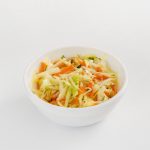What’s fiber got to do with it?
November is diabetes awareness month, which is an opportunity to highlight how diabetes affects our communities, strategies for prevention, and ways to treat and manage this chronic condition. Nutrition is an important aspect of preventing and managing diabetes. One of the most essential foods to eat with diabetes, which often gets overlooked, is fiber! Fiber has many different categories and food sources. Insoluble fiber is the type of fiber that remains intact through digestion and, therefore, isn’t a source of calories. Insoluble fiber is important for our digestive systems by preventing constipation. Soluble fiber is digested, creating a gel-like substance in our GI tracts that helps lower cholesterol and manage blood sugar levels! Fiber also helps slow digestion, which helps keep us full and prevents overeating. Furthermore, since fiber slows digestion it can help prevent blood sugar spikes. Some examples of insoluble fiber include brown rice, whole wheat bread, and seeds. Sources of soluble fiber include apples, carrots, beans, and oatmeal. Eat a variety of all these types of fiber to promote your best nutrition!




0 Comments